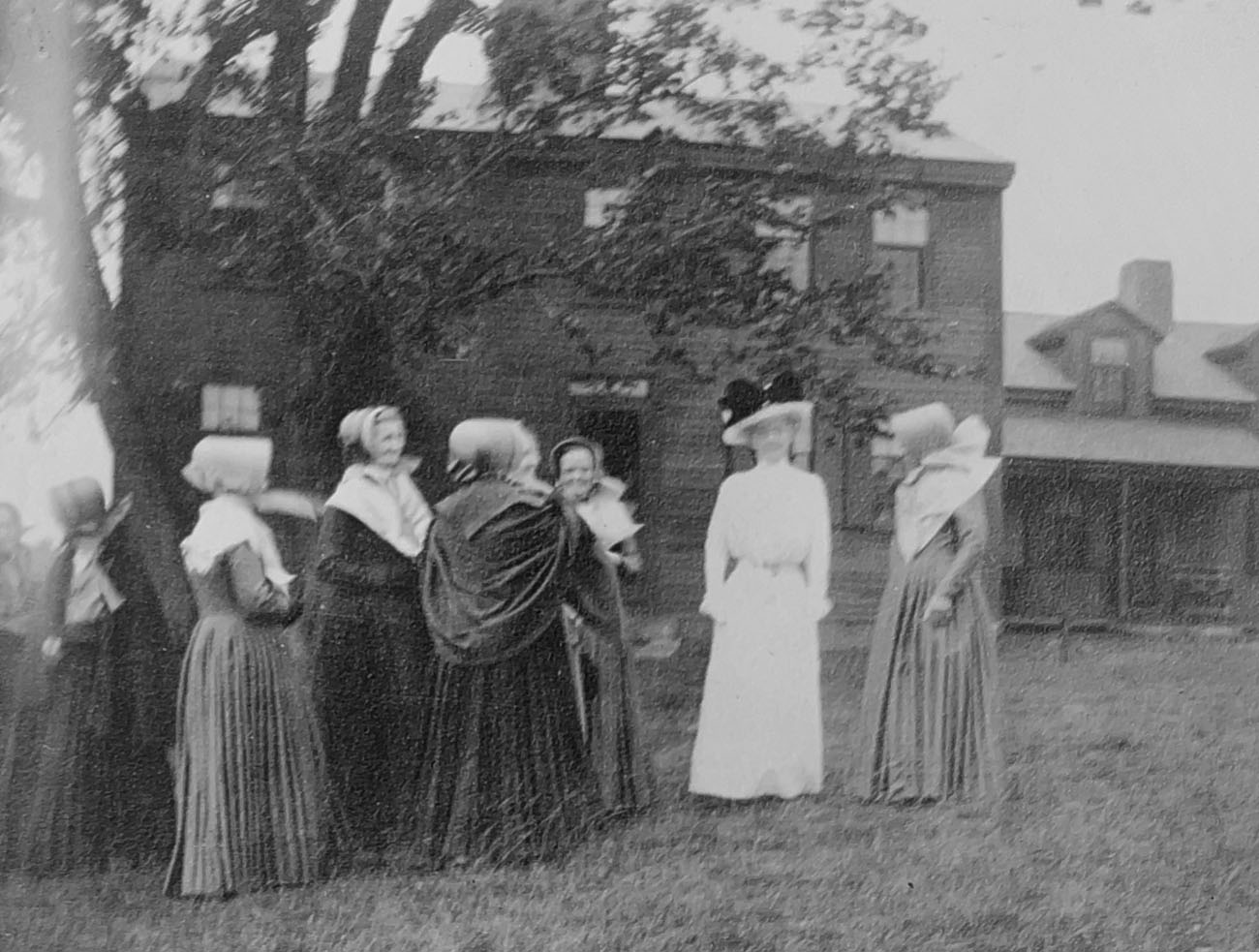
Two Canterbury NH Shaker sisters standing in front of a frozen waterfall. 1870-1920

A group of MA Shaker sisters, with a "worldly" or non-Shaker man, 1855-1910.
Growing Our Collection
With the Trustees acquisition of Fruitlands Museum in 2016, the Archives & Research Center staff in Sharon were amazed at the number of queries that came flooding in regarding the Shaker Museum collections and that the Shakers would become the leading query topic from scholars. Because the collections came to us in various states of organization, we have been chipping away at organizing the collections with the support of several state and federal grants to process, rehouse, digitize, and care for over 20 linear feet of Shaker materials. You can now find the processed collections online here.
There is still more to do, but most recently, we finished part of an IMLS (Institute of Museum & Library Services) grant that allowed us to hire a project archivist, Stephanie Bennett Rahmat, to process the Fruitlands Shaker Photographic Collection. Now we can easily share information about nearly 700 photographic items that span from 1855 to 1984 with many digitized. Over ten different photographic types of materials were reviewed. Glass plate negatives were cleaned and rehoused with the help of Northeast Documentary Conservation Center (NEDCC). But most importantly, nearly all the images have now been identified!

An unidentified Shirley Shaker brother, 1860-1908

An unidentified Shirley Shaker brother, 1860-1908, glass plate negative
A Work in Progress
Stephanie worked with other Shaker museums, local historical societies, and independent Shaker scholars to confirm – or disprove! – the existing captions, identify the unknown photographs, and add information to images that were only partially identified.
The Shakers were arguably the most successful communal society in the nineteenth century. By the mid-nineteenth century there were 18 Shaker villages in the United States. All told, these villages had a population totaling about 3600 members in the middle of the 19th century. At their height in 1850, the Harvard MA community had about 150 members and the Shirley MA community had about 100. Declining membership forced the Shirley community to close in 1908, followed closely by Harvard in 1918. In 1918 Harvard’s properties were sold to Boston industrialist and “one tax” proponent, Fiske Warren. Shirley’s property was sold to the State of Massachusetts. Today the site is a prison.
Clara Endicott Sears
In 1916, Fruitlands Museum founder, Clara Endicott Sears wrote about her Harvard neighbors, saying, “It has been my great privilege to be counted as a friend among the Shakers.” Sears began collecting materials directly from the Harvard and Shirley communities and was among the earliest Shaker collectors in the country. Sears bought the old Shaker office from Fiske Warren and moved it two miles to its present location on Fruitlands Museum grounds. She opened this building to the public in 1922, the first Shaker Museum in the world. Sears was also in regular contact with the Shaker communities in Mount Lebanon (New York), Canterbury (New Hampshire), and Sabbathday Lake (Maine).
Of about 1200 people who joined the Harvard Shakers, only one third died as Shakers, the other two thirds left the community. The village population growth initially relied on entire families joining the village, providing land, labor, and skills. Later on, orphans or children from poorer families were brought to the Shakers.

Harvard, MA Shakers visiting Fruitlands Museum in 1914

Clara E. Sears and a group of Harvard Shaker sisters in front of the Fruitlands Farmhouse, 1915
Highlights
The processing work at the Archives & Research Center (ARC) has already allowed us to share materials with scholars in their research into the herbal business that was led by a Harvard Shaker Elisha Myrick and the industrial buildings of the Harvard villages. Foot notes of articles. Their research has expanded our understanding of the Harvard Shakers and other groups represented in our collection. An ARC partnership with American Ancestors had volunteers transcribe over 14,000 membership records from five volumes kept by these two communities. These member names are now online in a database called Massachusetts; Shaker Records of the Fruitlands Museum, 1791-1918.


Harvard Shaker, Elizjah Myrick, 1855-1890

Herb House, Harvard Shaker Village, 1890-1910



